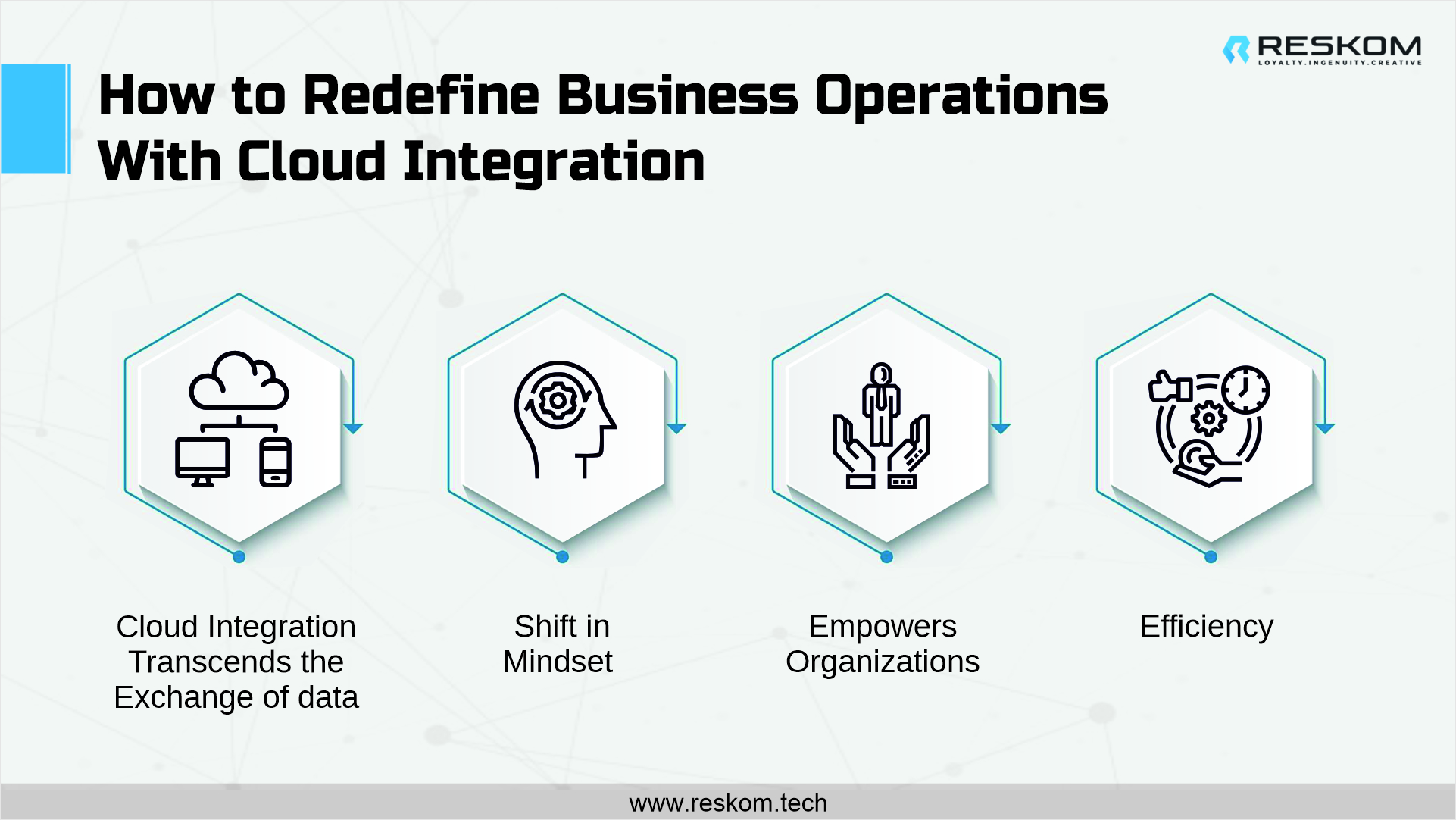The age-old challenge of data silos has found a formidable adversary in the form of cloud integration. The integration of cloud-based tools and technologies has ushered in a new era of possibilities, enabling organizations to bridge the gap between disparate systems and achieve seamless data exchange.
This transformative approach brings forth a host of advantages that extend from flexibility and scalability to enhanced connectivity and operational efficiency. In this blog, we will delve into the realm of cloud integration, exploring its various facets, benefits, and how it is reshaping the business landscape.

Understanding Cloud Integration
This process of cloud integration can span both fully cloud-based deployments and hybrid configurations, with the ultimate goal of creating a unified IT infrastructure that ensures a smooth flow of data. This integrated cloud environment opens doors for data access from multiple devices over a network or the internet.
Advantages of Cloud Integration
The adoption of the process of cloud integration solutions has gained momentum due to its profound impact on breaking down data silos, enhancing connectivity, and optimizing business processes. As the usage of Software as a Service (SaaS) solutions becomes increasingly prevalent, cloud integration’s significance escalates.
A surge in multi-cloud strategies, with over 90 percent of enterprises embracing them, coupled with the impending dominance of SaaS over traditional product delivery, underscores the urgency for robust cloud data integration methods. Moreover, the convergence of SaaS and on-premises applications has spurred the demand for progressive integration solutions.
Empowering Operational Excellence
The advantages that cloud platform integration offers are manifold. Enhanced operational efficiency stands as a primary gain, with integrated systems eliminating redundancies and automating processes. This synergy ensures that resources are utilized optimally and tasks are streamlined, translating to accelerated business growth with the process of cloud integration.
Flexibility and Scalability Unleashed
The hallmark of cloud platform integration is its flexibility and scalability. Businesses can swiftly adapt to changing needs, seamlessly incorporating new applications and scaling resources as required. This agility enables rapid responses to market dynamics and paves the way for innovation.
Accelerating Time-to-Market
The process of cloud integration expedites time-to-market by expelling the bottlenecks caused by data silos. With data flowing seamlessly between applications, development cycles are shortened, allowing products and services to reach consumers faster, gaining a competitive edge.
Seamless Internal Communication
Clear communication is the cornerstone of successful enterprises. Cloud integration fosters communication by providing a shared platform where data can be accessed and understood uniformly across departments. This harmony in communication catalyzes informed decision-making.
Enhancing Customer Interactions
Customer-centricity is elevated through cloud integration. With unified data, customer service and support teams can access real-time information, leading to personalized and effective interactions. This nurturing of customer relationships fuels loyalty and retention.
Competitive Edge Amplified
The competitive landscape benefits from cloud integration. Businesses armed with integrated data can make informed strategic decisions, spot trends early, and swiftly adapt to market shifts, thus staying ahead in the race.
Optimizing Costs and Revenue
Cloud integration is not just about expenditure but also revenue optimization. By trimming operational costs through efficiency and automation, organizations can channel resources to revenue-generating initiatives, bolstering their financial health.
Exploring Cloud Integration Types and Methods
Cloud integration comes in diverse flavors, encompassing cloud-to-cloud integration, cloud-to-on-premises integration, or a hybrid amalgamation of both. These integrations can span various business components, including data and applications.
Data Integration
This involves synchronizing data across repositories, encompassing processing, transport, and transformation. It ensures that data remains consistent and updated across the organization.
Application Integration
Beyond data sharing, application integration connects various applications to ensure uninterrupted functionality and interoperability. It empowers the triggering of business events and processes through commands and requests.
Embracing the Future with Cloud Integration
The complexity of modern business ecosystems demands scalable and agile solutions for integration challenges. While some organizations opt to build their integration solutions, the ever-expanding array of applications and intricate integrations make this approach less viable. The use of a cloud integration platform emerges as a pragmatic choice, offering an agile, scalable, and reusable solution that caters to both data and application integration needs.
In the dynamic landscape of modern business, cloud integration emerges as a transformative force, reshaping the way organizations approach data connectivity and operational efficiency. This section delves into the profound influence of cloud integration and its role in redefining business operations.
How to Redefine Business Operations With Cloud Integration
Cloud integration transcends the exchange of data
It embodies a holistic paradigm shift that unites applications, systems, repositories, and IT environments. This convergence facilitates real-time data sharing and process synchronization, enabling organizations to operate cohesively across diverse platforms.
Shift in mindset
Beyond the technical aspects, cloud integration represents a shift in mindset—a departure from traditional data silos toward a more integrated, agile, and collaborative approach.
Empowers organizations
The impact of cloud integration reverberates through various dimensions of business. It empowers organizations to break down data barriers, enhancing the flow of information and insights.
Efficiency
This newfound connectivity brings operational efficiency to the forefront, streamlining processes and minimizing redundancies. By eliminating manual data transfer and automating tasks, businesses can allocate resources more strategically, fostering innovation and growth.
Synergy Unleashed: Navigating Cloud Integration Mechanics
At the heart of cloud integration lies a complex web of mechanisms that orchestrate seamless connectivity. This section delves into the intricacies of these mechanics, shedding light on how SAP cloud integration unleashes synergy among diverse components.
Cloud integration operates under various names, such as cloud data integration and cloud system integration. Its essence lies in creating a unified IT infrastructure that enables real-time data exchange and process coordination. This requires not only technical integration but also a deep understanding of business processes and goals.
The technical underpinnings of SAP cloud integration involve API (Application Programming Interface) interactions, data transformation, and workflow automation. APIs facilitate communication between applications, allowing them to work in harmony.
Data transformation ensures that information is compatible and consistent across platforms, while workflow automation triggers actions based on predefined conditions. These mechanics together enable the seamless flow of data, whether it’s between cloud-based applications or a hybrid configuration.


